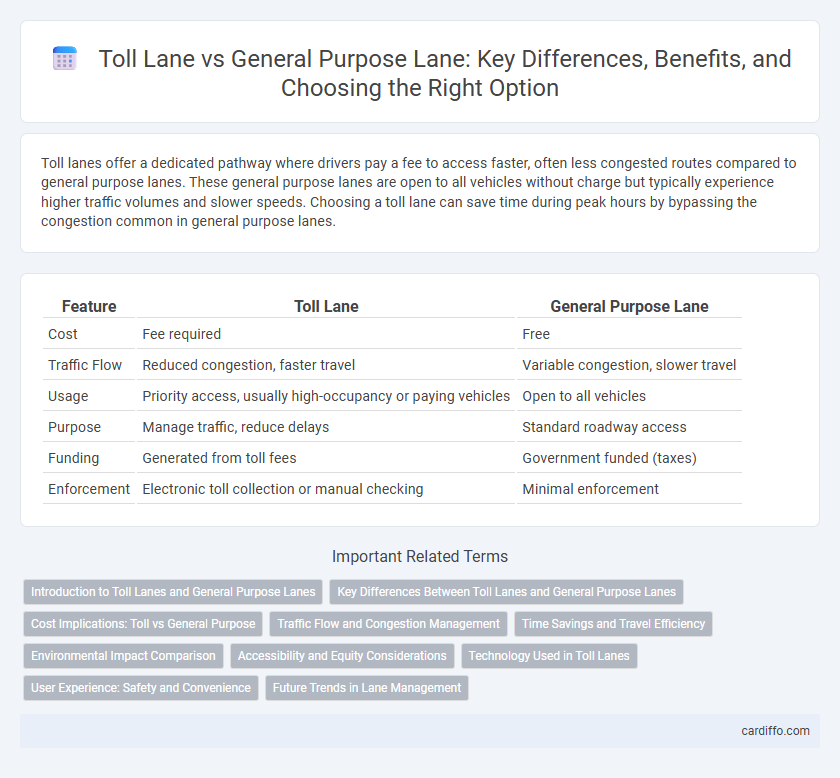Toll lanes offer a dedicated pathway where drivers pay a fee to access faster, often less congested routes compared to general purpose lanes. These general purpose lanes are open to all vehicles without charge but typically experience higher traffic volumes and slower speeds. Choosing a toll lane can save time during peak hours by bypassing the congestion common in general purpose lanes.
Table of Comparison
| Feature | Toll Lane | General Purpose Lane |
|---|---|---|
| Cost | Fee required | Free |
| Traffic Flow | Reduced congestion, faster travel | Variable congestion, slower travel |
| Usage | Priority access, usually high-occupancy or paying vehicles | Open to all vehicles |
| Purpose | Manage traffic, reduce delays | Standard roadway access |
| Funding | Generated from toll fees | Government funded (taxes) |
| Enforcement | Electronic toll collection or manual checking | Minimal enforcement |
Introduction to Toll Lanes and General Purpose Lanes
Toll lanes are specialized roadways where drivers pay fees to access faster, less congested travel routes, often equipped with electronic toll collection systems. General purpose lanes are open to all vehicles without charges, typically experiencing higher traffic volumes and slower speeds. The primary distinction lies in toll lanes offering managed traffic flow through pricing, while general purpose lanes serve as free, standard travel paths.
Key Differences Between Toll Lanes and General Purpose Lanes
Toll lanes require drivers to pay a fee for usage, offering faster travel times and reduced congestion compared to general purpose lanes, which are free but often more crowded. Toll lanes use electronic toll collection systems enabling seamless payment, while general purpose lanes do not impose access fees. Traffic management in toll lanes prioritizes efficiency and time savings, whereas general purpose lanes accommodate all vehicles without restrictions.
Cost Implications: Toll vs General Purpose
Toll lanes typically involve a direct fee paid by drivers, which can vary based on distance traveled, time of day, or congestion levels, resulting in higher immediate costs compared to general-purpose lanes. General-purpose lanes do not require toll payments but may incur indirect costs such as increased fuel consumption and travel time during peak traffic due to congestion. Choosing toll lanes often balances the higher monetary expense with time savings and reduced fuel costs, influencing overall travel cost efficiency.
Traffic Flow and Congestion Management
Toll lanes utilize dynamic pricing to regulate traffic flow, reducing congestion by incentivizing drivers to choose alternative routes or off-peak travel times. General purpose lanes often experience higher volumes and slower speeds due to unregulated access, leading to increased congestion during peak hours. Implementing toll lanes improves overall traffic efficiency by maintaining consistent speeds and managing demand through variable toll rates.
Time Savings and Travel Efficiency
Toll lanes significantly reduce travel time by offering less congested routes compared to general purpose lanes, enabling drivers to bypass heavy traffic during peak hours. These lanes optimize travel efficiency by maintaining higher average speeds and minimizing stop-and-go conditions, which are common in general purpose lanes. Studies show that vehicles using toll lanes experience up to 25% faster commute times, enhancing overall traffic flow and reducing total travel duration.
Environmental Impact Comparison
Toll lanes reduce traffic congestion by encouraging carpooling and minimizing vehicle idling, leading to lower emissions compared to general purpose lanes. The controlled access and variable pricing of toll lanes optimize traffic flow, which decreases fuel consumption and air pollution. Conversely, general purpose lanes often experience heavier traffic and stop-and-go conditions, resulting in higher greenhouse gas emissions and greater environmental impact.
Accessibility and Equity Considerations
Toll lanes often provide faster travel options through pricing mechanisms while raising accessibility concerns for low-income drivers who may be priced out of these lanes. General purpose lanes offer equitable access without additional fees but can suffer from congestion and slower travel times. Balancing toll lane implementation with equitable transportation policies is critical to ensure all users benefit fairly from road infrastructure.
Technology Used in Toll Lanes
Toll lanes utilize advanced technologies such as electronic toll collection (ETC) systems, RFID transponders, and automated license plate recognition (ALPR) to enable seamless vehicle identification and payment processing. These technologies reduce congestion by allowing vehicles to pass without stopping, enhancing traffic flow compared to general purpose lanes that lack toll-specific infrastructure. Integration of real-time data analytics and dynamic pricing algorithms in toll lanes further optimizes revenue collection and manages traffic demand efficiently.
User Experience: Safety and Convenience
Toll lanes generally offer a safer and more convenient user experience compared to general purpose lanes due to reduced congestion and regulated traffic flow, which minimizes sudden stops and accidents. Advanced electronic toll collection systems eliminate the need for physical stops, enhancing safety by reducing rear-end collisions and improving travel time reliability. Users benefit from clearer lane markings and dedicated signage in toll lanes, which streamline navigation and decrease driver stress.
Future Trends in Lane Management
Toll lanes are increasingly integrated with advanced traffic management systems using real-time data analytics and dynamic pricing models to optimize lane usage and reduce congestion. Future trends emphasize the expansion of high-occupancy toll (HOT) lanes, leveraging connected vehicle technology and AI-driven algorithms for adaptive lane allocation and seamless toll collection. These innovations aim to enhance traffic flow efficiency, lower emissions, and provide equitable access while supporting smart city infrastructure development.
Toll Lane vs General Purpose Lane Infographic

 cardiffo.com
cardiffo.com